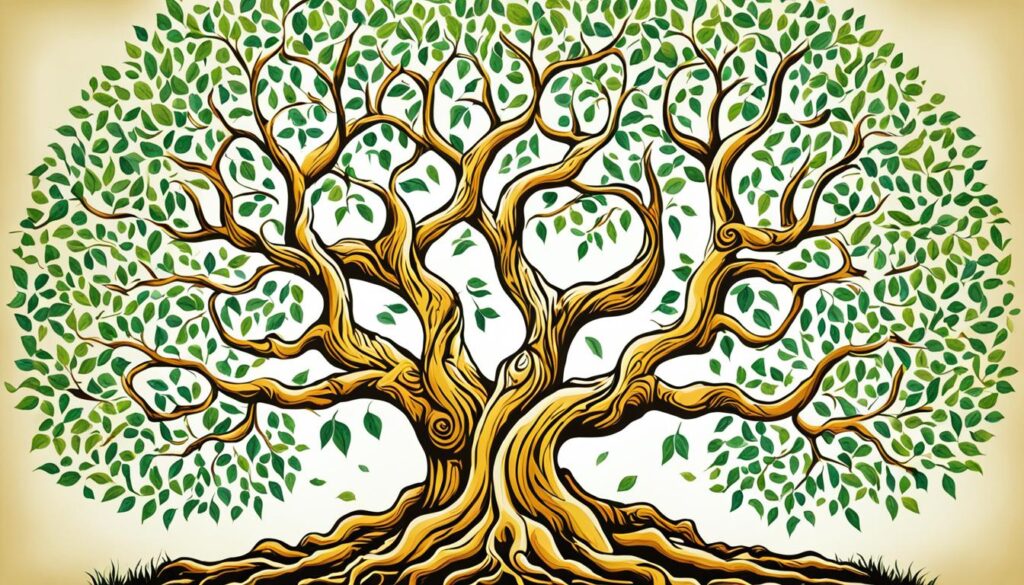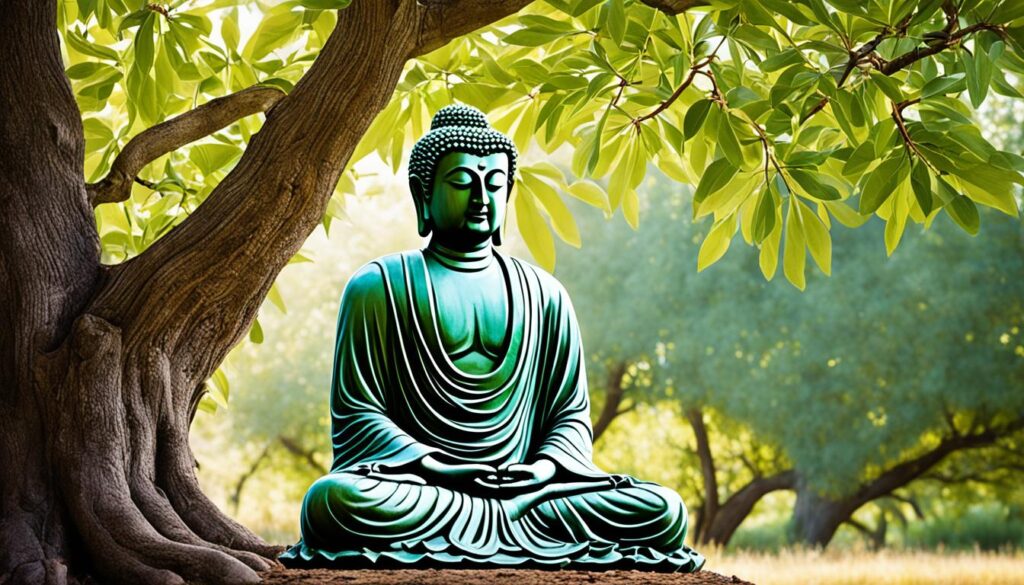“Thousands of candles can be lit from a single candle, and the life of the candle will not be shortened. Happiness never decreases by being shared.” – Buddha
Discover the profound teachings that have guided countless individuals on a transformative journey towards inner peace and enlightenment. Buddhism, an ancient philosophy and way of life, offers a unique perspective on the nature of existence and human suffering. By delving into the core beliefs of Buddhism, you will unlock the wisdom and insights that can bring harmony and clarity to your own life.
Key Takeaways:
- Buddhism is a philosophy centered around understanding suffering and seeking liberation from it.
- The Four Noble Truths, the law of karma, and the quest for Nirvana form the core beliefs of Buddhism.
- Buddhism teaches the impermanence of life, the illusion of self, and the importance of compassion and mindfulness.
- The essence of Buddhism lies in recognizing suffering, understanding desires, and following the path to ultimate freedom.
- The founder of Buddhism, Siddhartha Gautama, known as the Buddha, dedicated his life to teaching his insights.
The Foundation: Three Fundamental Beliefs
The foundation of Buddhism is built upon three fundamental beliefs that serve as pillars of understanding and practice. These beliefs lay the groundwork for individuals seeking to explore the path of enlightenment and inner peace. Let’s delve deeper into these core tenets that form the bedrock of Buddhism.
The Four Noble Truths
The first fundamental belief in Buddhism revolves around the Four Noble Truths. These truths serve as the roadmap to liberation from suffering:
- Dukkha – The recognition that suffering is an integral part of life.
- Samudaya – The understanding that suffering arises from desire and attachment.
- Nirodha – The realization that suffering can cease by eliminating desire and attachment.
- Magga – The Eightfold Path that leads to the cessation of suffering and the attainment of enlightenment.
The Law of Karma
Another fundamental belief in Buddhism is the law of karma, which explains the consequences of our thoughts, words, and actions. According to this law, every action has an effect, shaping our present circumstances and influencing future rebirths. By understanding and practicing karma, individuals are encouraged to cultivate wholesome actions that lead to positive outcomes and ultimately liberation.
The Quest for Nirvana
The final fundamental belief of Buddhism revolves around the quest for Nirvana. Nirvana, often described as the ultimate state of liberation and enlightenment, transcends the cycle of rebirth and suffering. The pursuit of Nirvana is a central aspiration for Buddhist practitioners, motivating them to embark on a transformative journey of self-discovery, mindfulness, and compassion.
These three fundamental beliefs form the foundation upon which Buddhism is established. By embracing the Four Noble Truths, understanding the impact of karma, and striving for enlightenment and liberation through the quest for Nirvana, individuals can embark on a profound spiritual path towards inner peace and awakening.

The Summit: Five Central Beliefs
In the journey towards enlightenment, Buddhism presents five central beliefs that serve as the summit of its teachings. These beliefs encompass the essence of Buddhist philosophy, guiding individuals on the path to inner peace and awakening.
- Embracing Impermanence: Buddhism teaches us to embrace the inherent impermanence of all things. By acknowledging the transitory nature of existence, we find liberation from attachments and cravings that cause suffering.
- Challenging the Illusion of Self: Buddhism challenges the commonly held notion of a fixed and independent self. Through profound self-reflection and meditation, we realize that our identity is merely a collection of impermanent elements and experiences.
- Cultivating Compassion: Compassion lies at the core of Buddhism. By radiating compassion towards all living beings, we transcend our ego-centric perspective and develop a deep sense of interconnectedness with the world around us.
- Following the Middle Way: Buddhism advocates for living a balanced and harmonious life by following the Middle Way. This path avoids extremes and encourages a moderate approach to both worldly desires and asceticism.
- The Power of Mindfulness: Central to Buddhist practice is the power of mindfulness. Through meditation and mindful awareness of the present moment, we cultivate a deep understanding of ourselves and the world, fostering wisdom and potential for transformation.
The journey towards embracing these central beliefs requires dedication, self-reflection, and practice. By incorporating these principles into our daily lives, we open ourselves to the transformative wisdom that Buddhism offers.
The Essence: Ten Core Tenets
Buddhism’s essence lies in ten core tenets that form the foundation of this ancient philosophy and way of life. These tenets encapsulate key principles that guide Buddhists on their spiritual journey. Understanding and embracing these core beliefs can bring about profound transformation and liberation from suffering.
1. Dukkha: The Recognition of Suffering
The first core tenet is the recognition of suffering (dukkha) as an inherent part of human existence. Buddhism teaches that life is inherently unsatisfactory and that suffering arises from attachment and craving.
2. Samudaya: The Origin of Suffering
The second tenet is the understanding of the origin of suffering (samudaya). Buddhists believe that suffering arises from desire and attachment to worldly pleasures and the illusion of a fixed self.
3. Nirodha: The Cessation of Suffering
The third tenet is the cessation of suffering (nirodha). Buddhism offers a path to liberation from suffering by eliminating desire, attachment, and ignorance.
4. Magga: The Eightfold Path
The fourth core tenet is the Eightfold Path (magga), which serves as a guide for ethical conduct, mental discipline, and wisdom. It encompasses eight interconnected practices, including right understanding, intention, speech, action, livelihood, effort, mindfulness, and concentration.
5. Karma: Law of Cause and Effect
The fifth tenet is the law of karma, which states that our actions have consequences. Buddhists believe that our actions shape our future experiences and that cultivating wholesome actions leads to positive outcomes.
6. Samsara: The Cycle of Rebirth
The sixth core tenet is the concept of samsara, the cycle of rebirth. Buddhists believe in the continuity of consciousness across lifetimes and the opportunity to break free from the endless cycle of birth, death, and rebirth.
7. Anicca: Impermanence of All Things
The seventh tenet is the recognition of the impermanence of all things (anicca). Buddhism teaches that everything in the world is transient and subject to change, including our thoughts, emotions, and physical experiences.
8. Anatta: The Illusion of a Fixed Self
The eighth tenet is the illusion of a fixed self (anatta). Buddhists reject the notion of a permanent, unchanging self and recognize the interconnectedness and impermanence of all phenomena.
9. Metta: Cultivating Loving-Kindness
The ninth tenet is the cultivation of loving-kindness (metta). Buddhism encourages practitioners to develop compassion, empathy, and unconditional love towards all sentient beings.
10. Nirvana: Liberation from Suffering
The tenth and ultimate tenet is nirvana, the goal of liberation from suffering. It represents the state of enlightenment, where one realizes the true nature of existence and achieves liberation from the cycle of birth and death, transcending suffering completely.

The Core Essence: Four Pillars of Buddhism
Buddhism’s profound wisdom is encapsulated in the core essence of its teachings, expressed through four pillars that illuminate the path to spiritual liberation. These pillars invite you to deepen your understanding of life’s reality, explore the hidden desires that bind you, embrace the calling of Nirvana, and embark on the transformative journey of the Eightfold Path towards freedom from suffering.
Acknowledging Life’s Reality
The first pillar invites you to face the undeniable truth of life’s impermanence and the inherent nature of suffering. By acknowledging the challenges and difficulties that arise, you can cultivate wisdom and develop resilience in the face of adversity. Through this awareness, you can learn to navigate the ever-changing nature of existence with grace and equanimity.
Unveiling Desires and Attachments
The second pillar encourages you to delve into the depths of your own desires and attachments, unraveling the intricacies of the human mind. By recognizing and understanding the causes of suffering rooted in craving and attachment, you can gradually free yourself from their grip. This inquiry leads to self-discovery and empowers you to live a life aligned with your true nature.
The Symbolism of Nirvana as Liberation
The third pillar inspires you to explore the profound symbolism of Nirvana, the ultimate goal of the Buddhist path. Nirvana represents the liberation from the cycle of birth and death, the extinguishment of suffering, and the attainment of true peace and enlightenment. It serves as a constant reminder of the transformative power that lies within, beckoning you to transcend the limitations of worldly existence.
The Eightfold Path: The Path to Freedom
The fourth pillar guides you towards the Eightfold Path, a systematic approach that leads to the cessation of suffering and the realization of liberation. This path encompasses elements such as right understanding, right intention, right speech, right action, right livelihood, right effort, right mindfulness, and right concentration. Practicing these teachings empowers you to cultivate wholesome qualities, develop clarity of mind, and live in alignment with the principles of truth, integrity, and compassion.

These four pillars act as beacons of light, illuminating the path to freedom and awakening. As you deepen your understanding of Buddhism’s core essence, may you find solace, inspiration, and guidance in your quest for truth and inner peace.
Founder of Buddhism
Buddhism traces its roots back to Siddhartha Gautama, also known as the Buddha, who lived during the 5th century BCE. After years of seeking enlightenment, he attained it under a Bodhi tree and dedicated his life to teaching others about his insights.

Driven by a deep desire to understand the nature of suffering and the path to liberation, Siddhartha Gautama embarked on a spiritual quest that led him to profound realizations. Sitting in deep meditation, Siddhartha attained enlightenment and became the Buddha, meaning “the awakened one.”
Throughout his life, the Buddha traveled extensively, delivering teachings and sharing his wisdom with countless individuals from all walks of life. His teachings focused on the Four Noble Truths, the law of karma, and the pursuit of Nirvana.
The Buddha’s teachings emphasized the importance of self-transformation, compassion, and mindfulness as fundamental aspects of spiritual growth. By following his teachings, individuals could liberate themselves from the cycle of suffering and attain true enlightenment.
Types of Buddhism
Buddhism encompasses various types and branches that have developed over time. Each branch offers its unique perspectives and practices, providing individuals with diverse paths towards spiritual growth and enlightenment. Let’s explore some of the prominent forms of Buddhism:
Theravada Buddhism
Theravada Buddhism, also known as the “Doctrine of the Elders,” is primarily practiced in Southeast Asia. It is considered the oldest surviving school of Buddhism, tracing its origins back to the teachings of the historical Buddha, Siddhartha Gautama. Theravada emphasizes meditation, self-discipline, and the understanding of one’s mind to achieve liberation from suffering.
Mahayana Buddhism
Mahayana Buddhism, meaning the “Great Vehicle,” is prevalent in East Asia, including China, Japan, and Korea. Mahayana teachings encourage compassion, wisdom, and the pursuit of enlightenment for the benefit of all sentient beings. This branch emphasizes the potential for all individuals to attain Buddhahood and places importance on religious texts known as sutras.
Tibetan Buddhism
Tibetan Buddhism, also known as Vajrayana Buddhism, holds a significant presence in Tibet and northern India. It combines elements from both Theravada and Mahayana traditions with unique tantric practices. Tibetan Buddhism places great emphasis on the guidance of spiritual leaders, the Dalai Lama being the most renowned, and incorporates intricate rituals, chanting, and visualizations.
Zen Buddhism
Zen Buddhism, derived from the Chinese word “Chan,” is a school of Mahayana Buddhism that focuses on direct experiential insight and meditation. Zen emphasizes the cultivation of mindfulness and presence in everyday activities, aiming to attain enlightenment through a non-dualistic understanding of reality. It is well-known for its simple yet profound teaching methods, including silent meditation and the practice of koans, paradoxical statements or questions that help transcend conceptual thinking.
Nirvana Buddhism
Nirvana Buddhism is closely related to Theravada Buddhism and places a strong emphasis on the concept of ultimate enlightenment, or nirvana. Practitioners of this branch prioritize the cessation of suffering and the attainment of liberation from the cycle of rebirth. The path to nirvana involves deep self-reflection, meditation, and the application of Buddha’s teachings to life.
| Type of Buddhism | Key Features |
|---|---|
| Theravada Buddhism | Emphasizes meditation and self-discipline |
| Mahayana Buddhism | Focuses on compassion, wisdom, and enlightenment for the benefit of all sentient beings |
| Tibetan Buddhism | Incorporates tantric practices, rituals, and guidance from spiritual leaders |
| Zen Buddhism | Emphasizes direct experiential insight through meditation and mindfulness |
| Nirvana Buddhism | Places strong emphasis on attaining ultimate enlightenment and liberation from suffering |
These various types of Buddhism offer individuals the opportunity to embark on their unique spiritual journeys, seeking wisdom, peace, and liberation from suffering. Each branch provides a distinct approach and set of practices, allowing practitioners to explore Buddhism’s profound teachings and discover their path towards enlightenment.
Conclusion
Buddhism offers profound insights into the nature of existence and the human experience of suffering. Its core beliefs, including the Four Noble Truths, the law of karma, and the quest for Nirvana, provide a powerful roadmap towards enlightenment and inner peace.
By embracing the teachings and practices of Buddhism, you can embark on a transformative journey of self-discovery and spiritual growth. Buddhism teaches you to confront the realities of life, to understand the impermanence of all things, and to cultivate compassion and mindfulness.
Through the core teachings of Buddhism, you can find a path to enlightenment and transcend suffering. By letting go of attachments, embracing the middle way, and practicing loving-kindness, you can attain inner peace and free yourself from the cycle of rebirth.
Incorporating Buddhist teachings into your life can lead to profound personal growth, awakening, and liberation from suffering. Discover the path to enlightenment, embrace inner peace, and embark on a transformative journey with the timeless wisdom of Buddhism.
FAQ
What are the core beliefs of Buddhism?
The core beliefs of Buddhism include the recognition of suffering, the law of karma, and the quest for Nirvana.
What are the Three Fundamental Beliefs in Buddhism?
The Three Fundamental Beliefs in Buddhism are the Four Noble Truths, the law of karma, and the quest for Nirvana.
What are the Five Central Beliefs in Buddhism?
The Five Central Beliefs in Buddhism include embracing impermanence, questioning the notion of a fixed self, cultivating compassion, following the middle way, and harnessing the power of mindfulness through meditation.
What are the Ten Core Tenets of Buddhism?
The Ten Core Tenets of Buddhism include the recognition of suffering (dukkha), the origin of suffering (samudaya), the cessation of suffering (nirodha), the Eightfold Path (magga), the law of karma, the cycle of rebirth (samsara), the impermanence of all things (anicca), the illusion of a fixed self (anatta), loving-kindness (metta), and the ultimate goal of liberation from suffering (nirvana).
What are the Four Pillars of Buddhism?
The Four Pillars of Buddhism are acknowledging the reality of suffering, understanding its roots in desires and attachments, the symbolism of Nirvana as liberation, and the Eightfold Path as the guide to attain freedom from suffering.
Who is the founder of Buddhism?
The founder of Buddhism is Siddhartha Gautama, also known as the Buddha.
What are the types of Buddhism?
The types of Buddhism include Theravada Buddhism, Mahayana Buddhism, Tibetan Buddhism, Zen Buddhism, and Nirvana Buddhism.
What does Buddhism offer in terms of inner peace and enlightenment?
Buddhism offers profound insights and teachings that can guide individuals towards inner peace, enlightenment, and liberation from suffering.

